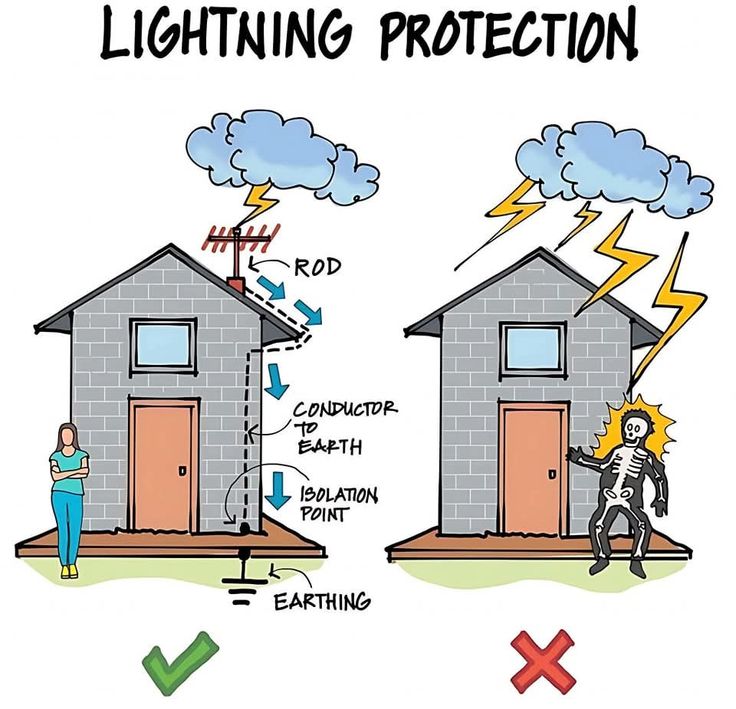
A simple yet effective diagram circulating online does an excellent job of demystifying one of history’s great inventions: the lightning rod. It clearly and correctly illustrates how a basic lightning protection system can intercept a powerful strike and guide it safely to the ground, protecting a home from a devastating fire.
While this diagram perfectly explains the first and most visible line of defense, it omits the other half of the story. The most common mistake a modern homeowner can make is believing this system alone is enough. In today’s electronically-driven world, the greatest and most costly threat from lightning is often completely invisible until it’s too late.
Step 1: The Classic Defense – Taming a Direct Strike
The diagram flawlessly illustrates the three-part principle of a traditional lightning rod system, a technology that has been protecting buildings for centuries.
- Interception: A metal Rod (properly called an air terminal) is placed at the highest point of the roof. It does not “attract” lightning, but rather provides a safe and highly conductive target for a lightning strike that was going to happen anyway. This intercepts the electrical charge, preventing it from blasting through the roof structure and potentially starting a fire.
- Conduction: The immense energy of the strike is then channeled into a heavy-duty Conductor to Earth (typically a thick copper or aluminum cable). This acts as a safe “expressway” for the electricity, guiding it down the exterior of the house.
- Grounding: The conductor cable is connected to an Earthing rod (or a series of rods) driven deep into the ground. This allows the massive electrical charge to be safely dispersed into the earth, its final destination.
This fundamental system is the cornerstone of protecting a building’s physical structure from the destructive heat and force of a direct hit.
Step 2: The Critical Mistake – Ignoring the Invisible Surge
The critical mistake is assuming your home is safe just because it avoids a direct strike. Most lightning-related damage today is not caused by a direct hit, but by a powerful and destructive electrical surge.
- The Problem: When lightning strikes anywhere near your home—a utility pole, a nearby tree, or even the open ground a block away—it induces a massive spike in voltage in the surrounding power grid and other utility lines. This powerful surge, lasting only a fraction of a second, can travel through the main power lines, cable TV or internet lines, and even phone lines, entering your home with destructive force.
- The Consequences: This tidal wave of electricity is far more than your sensitive electronics can handle. It can instantly destroy televisions, computers, modems, smart-home systems, modern refrigerators, and HVAC control boards. It is the number one cause of costly lightning damage in modern homes.
The Correction: Whole-House Surge Protection
The essential second component of a complete system is a Surge Protection Device (SPD). This device is installed by an electrician at your main electrical panel and acts as a security guard for your entire home. It monitors the incoming electricity and, when it detects a dangerous surge, it instantly diverts the excess voltage safely into your home’s grounding system before it can race through your circuits and destroy your appliances.
Step 3: An Expert’s View on a Complete System
“The diagram shows you how to stop your house from burning down, which is a great start,” explains Frank Davies, a (fictional) contractor who specializes in storm damage repair. “But it doesn’t show you how to prevent your house from being electronically wiped out. We see this constantly after a big thunderstorm: the house itself is untouched, but the homeowner is facing ten thousand dollars in replacement costs for their appliances and electronics.”
“A complete lightning protection system is a two-part strategy,” he adds. “The rods and conductors on the outside protect the structure. The whole-house surge protector on the inside protects your modern life. You really need both for true peace of mind.”
A professional system also involves more than what is shown in the simple drawing. It typically includes a network of multiple air terminals connected by a loop of conductors, and “bonding,” which connects all of the home’s metallic systems (water pipes, gas lines) to the grounding system to prevent dangerous side-flashes. Due to its complexity, a lightning protection system should always be installed by a certified professional.
Conclusion: Protect Your Structure and Your Stuff
This simple diagram provides an invaluable lesson in the basic physics of lightning protection. But in an age where our homes are filled with sensitive and expensive electronics, the definition of “protection” has expanded.
A truly resilient home is one that is shielded from both the visible fire of a direct strike and the invisible threat of an electrical surge. As thunderstorms become more severe in many regions, investing in a complete, professionally installed lightning protection system—including whole-house surge protection—is one of the smartest decisions a homeowner can make to safeguard their property, their electronics, and their modern way of life.